| “ | SPQR - Senatus Populusque Romanus | ” |
–A popular motto. | ||
The Roman Empire (Imperium Rōmānum) was the period of Roman civilization that followed the Roman Republic, centered around the city of Rome that emerged in the area now known as Italy, a country in southern Europe. Its first emperor was Augustus, the grandnephew and adopted son of Gaius Julius Caesar. Julius Caesar became official dictator of the Roman Republic after he defeated Pompey the Great and the "Republican" faction of the Senate in a civil war. After Caesar's assassination in March 44 BC, Rome would be furtherly divided internally, with this second period of political instability culminating in another civil war, in which Augustus would emerge victorious.
Early History[]
The city-state of Alba Longa was founded by Aeneas after fleeing Troy. Later, Romulus and Remus, sons of Mars, left Alba Longa to found their own great city. They were supposedly raised by the immortal goddess/she-wolf, Lupa, and then found by a shepherd. An argument broke out over where to build the city; Remus wanted to build the city on the Aventine Hill, and Romulus on the Palatine Hill. They waited on their hills for an omen from the gods, Romulus saw more birds and decided to build his city there. Remus, angered by this, mocked his brother's walls by leaping over them. Romulus killed his brother in a fit of rage and the city of Rome was founded in 753 BC.
After a period of seven kings, the last king of Rome, Lucius Tarquinius Superbus, was overthrown in 509 BC after his son, Sextus Tarquinius, raped a noblewoman named Lucretia who then committed suicide. The revolt was led by Lucius Junius Brutus, with Lucretia's father, Spurius Lucretius Tricipitinus, her husband, Lucius Tarquinius Collatinus, and another leading citizen named Publius Valerius Publicola. They gathered the youth of Collatia to Rome and all voted for the deposition of Tarquin the proud, the comitia curiata approved of this using the treatment of the king's wife, Tullia, as an example. Everyone agreed with Brutus that Rome would be better off without kings, so the Tarquin family was prevented from entering and exiled and the Roman Kingdom became the Roman Republic.[1]
The Roman Republic[]
While the fall of the last king had established Rome as a republic, the Senate was largely controlled by the patricians, or the rich upper class nobility. The lower class of plebeians left Rome twice in protest against the patricians' unfair rule in a series of events called the Secession of the Plebs. In response, the position of Tribune of the Plebs would be established to give the people a voice in Rome's politics. This Tribune was given the ability to veto the decisions of the consuls and the other magistrates, as well as call the Senate to meet. The Comitia Centuriata ("Assembly of Centuries") elected the consuls to be the leaders of the Roman Republic for one year. Unlike Camp Jupiter, the Roman senate and military tops were actually the consuls, who held power over the praetors. The Roman senate and people elected 2 consuls to command the main armies of the republic. The first conflict that was known was the Samnite wars. It encompassed giant armies being surrounded, crushing defeats on both sides and an intervention that did nothing but just annoyed the Romans with another easy task to face. The first and second wars ended with Roman victories. The majority of battles was won by Rome and they lost a few minor battles and one major one at the Claudine Forks.
In 295 BC, the consuls Publius Decius Mus and Quintus Fabius Maximus Rullianus destroyed a combined army of Etruscans, Umbrians, Samnites and Senone Gauls. In the battle, Rullianus fought defensively, using different counterattacks and feigned retreats. His colleague, Decius, had fought aggresively, making two cavalry charges but on the third one, they charged too far and were surrounded by Gallic cavalry and chariots. His cavalry ran back into the infantry, causing mass chaos and even causing some casualties by friendly fire. Publius decided that it was time to devote himself, he shouted at the top of his lungs, so that all the soilders can hear. "I carry before the gods terror, rout blood and carnage. I will infect their standards, armor and weapons with dire and manifold death!". With that, he charged into the Gallic lines and was instantly slain by some spears. The angered soilders advanced right into the fray of the fighting, pushing the Gauls back. Quintus Fabius sent three of his reserve maniples, led by Publius Cornelius Scipio Africanus's great grandfather. This rebalanced the battle and Quintus Fabius sent his cavalry sweeping in onto the Samnite lines on his side, causing a lot of casualties. Quintus Fabius then learned of his colleagues' death and sent the princepes of his second legion to surround the Gauls. The Gauls were slaughtered and the battle was over. The Romans lost 8,000 men and the Allied army had more than 22,000 casualties. Five years later, another Roman consul won the battle of Aquilonia and defeated the Samnites once and for all.
By 280 BC, Rome's borders had encompassed the whole of modern Italy, excluding Sicily and Sardinia. The emerging superpower soon found itself in conflict with the other Mediterranean superpower at the time, Carthage. The first war, based on Sicily, was the turning point for naval warfare. The Romans used a mighty fleet of 1000 galleys to destroy numerous smaller Carthaginian fleets, culminating at the battle of Ecnomus. In the battle, republican warships defeated the Carthaginians and following this, Rome was unchallenged in the Mediterranean. In the second one, Hannibal won the battle of Cannae, drawing the Romans into the centre to deliver a devestating blow to the flanks and rear. At Ilipa, Baecula and Zama, Publius Cornelius Scipio Africanus destroyed the Carthaginians using similar tactics of Hannibal. In the first two, Scipio caused more than 100,000 casualties and at the final showdown at Zama with Hannibal, he caused 40k casualties. At Zama, the Roman infantry held the line while the cavalry swept the Carthaginian cavalry from the field tirelessly, only to deliver a finishing blow to the rear and flanks to Hannibal's army. Rome had effectively controlled the sea with a fleet greater than the combined might of the Greek city-states and they now turned their vengeful gaze to the east, where various Greek city-states had allied with Hannibal Barca, a brilliant Carthaginian general.
In 197 BC, the Romans defeated the Macedonians and the whole Greek armies at the battle of Cynoscephalae, which showed the Legion's supremacy against the phalanx of Leonidas and Alexander the Great. It showed the flexibility of the maniple over the phalanx and Roman cavalry against Greek cavalry. Rome was now technically reigning supreme over the meditation but there was one more threat, the Selucid Empire, ruled by Antiochus the Great. The following battle of Magnesia showed the Legion's supremacy over the phalanx once again and Roman cavalry against more technologically advanced Seleucid cavalry. In the battle of Pydna, Roman forces led by Lucius Amelius Paullus Macedonicus scored a decisive victory over Perseus, king of Greece. Before the battle, the moon turned red. Had Zeus abandoned the Greeks? In the ensuing battle, the legion used some tactics used by the Roman consuls at Asculum, overwhelming the phalanx while the Roman cavalry carved a bloody swathe through the Thracian skirmishers and Greek cavalry. After the legion defeated the phalanx, Perseus fled. The Macedonian kingdom was forever gone and all the Greek city states would be defeated, even Sparta and Athens, at the battle of Corinth.
Rome also swept into the Asia Minor, also destroying Greek colonies such as Pontus. Humiliating them in the battles of Charonea, Orchemenus and Cyzicus. While also beating Armenia at Tigranocerta, Pontus’s most powerful ally, forcing Tigranes the great, who was a relative of the Pontic king Mithridates VI, to be a Roman vassal in order to stop it being completely conquered. The terms of the following peace treaty was that the Romans gained upper Mesopotamia, Syria, Lebanon, Upper Arabia, Selucia, Judea and many more others. In the few battles, more than 200,000 Pontics and Armenians were killed and dozens more were wounded, captured or missing. Rome captured Sinope , Ephesus and Smyrna in quick succession.
While the Republic had nearly doubled in size following the second war with Carthage, its economy had been severely weakened by the conscription of farmers. There were social and political crises. The brothers Gracchi tried to remake the distribution of land but were killed by the patricians. The general Gaius Marius made the Marian reforms in order to combat a Germanic threat and he defeated them outright at the Battles of Aquae Sextiae and Vercellae (102 and 101 BC) . In the two battles, more than 200,000 Germans were killed by Marius, Manius Aquilius and Caius Catalus Lutatius. The battles were easy for the Romans since they had superior infantry and cavalry and gained the upper hand almost immediately after the battles commenced, throwing their two pila and drawing their gladius. However, the following consul, Sulla, capitalised on the political turmoil in Rome itself and marched on Rome with six legions, gaining dictatorial powers soon after and he initiated a purge of the popular party, the list encompassing the young Gaius Julius Caesar. Rome's armies were no longer tied to the state, but rather, to the general that paid them and gave them land. The final nail in the coffin was Caesar's decision to cross the Rubicon and initiate a civil war which would see him installed as Dictator Perpetuo (Dictator in perpetuity), a position which effectively granted him supreme power. After the Parthian victory at Carrhae, the Romans avenged with the battles of the Cicilian Gates, Amanus Pass and Mt Gindaurus, where the Roman general Publius Ventidius Bassus killed the Parthians, with two large parthian armies gone and most of the nobility were killed, including a Prince, at Mt Gindaurus. Caesar’s dictatorship, combined with a corrupt senate, and generals controlling their own personal armies, lead to the eventual fall of the Republic at the hands of the First and the Second Triumvirate.
First Emperor of Rome[]
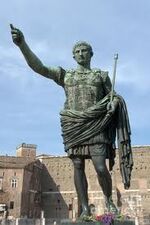
Augustus
Upon Caesar's assassination on the Ides of March (15 March) 44 BC, his will was read, where it was revealed that he had adopted Gaius Octavius, his grandnephew, as his son and heir. Taking on the name Gaius Julius Caesar Octavianus, the young heir soon made his way to Rome in July 44 BC, where he formed the Second Triumvirate, which consisted of himself, Marcus Antonius (Caesar's former consul and confident as well as a former husband of Cleopatra), and Marcus Aemilius Lepidus (a Roman patrician and military commande). They ultimately defeated Caesar’s assassins, but disputes between Octavianus and Antonius (who had allied himself with Queen Cleopatra VII of Egypt) lead to another civil war, with Octavianus emerging victorious. Following Antonius’ suicide in the aftermath of the Battle of Actium (2 September 31 BC), Octavianus returned to Rome triumphant. There, he was welcomed by the citizens of Rome and honored by the Senate, which was an empty shell of its former self (filled with pro-Octavian supporters).
On 16 January 27 BC, Octavianus, having relinquished the powers he had held while apart of the Second Triumvirate, was granted the honorary title of Augustus (“honorable” or “revered one”) by the Senate; his official name and title was Imperātor Caesar Dīvī Fīlius Augustus (“Commander Caesar, son of the deified one, he who is revered”). In practice, Augustus was an emperor, but in order to avoid Caesar's mistake of being too tyrannical and taking into account the hate that the Roman people had for monarchs, he referred to himself as Princeps Civitatis ("First citizen of the state"). Thus, his system of government was known as the Principate, which would last until around the time of Diocletian. He established the Pax Romana ("Roman Peace"), a period of relative peace, although wars continued to break out along the borders. He built great part of the road's network and courier system, stablished a police force (Vigiles) and fire-fighters. He was one of Rome's greatest rulers and created the imperial system that all the others emperors would follow.
Rome the Capital of the Empire[]
Rome, located on seven hills near the Tiber River and now stretched to the suburbs from the original location, was originally the capital of the resurgent Roman Republic. Once it became the capital of the Roman Empire, it prospered under the rule of Augustus and other Emperors. It's been said that during its peak, Rome reached the incredible mark of 2 million inhabitants.
The Expansion of Rome[]
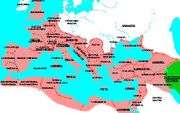
The Roman Empire
Before the Pyhrric war, the Samnite wars, Etruscan wars, Umbrian wars and wars with the senone gauls. By 280 BC, Rome's borders had encompassed the whole of modern Italy, excluding Sicily and Sardinia. The Magna Grecia territory was taken by Rome after landing a few severe blows to Pyhrrus of Epirus at Hercelea, Asculum and Beneventum. Carthage was taken by the senate together with Spain and a part of northern Africa. The commander Scipio Africanus took Hispania, Quintus Fabius Maximus cuncator retook great cities like Tarentum easy from Hannibal, Scipio defeated Hannibal at Zama even though he was numerically inferior and was facing the infamous war elephants of Carthage. Greece was easily conquered except for a few struggles such as Cynoscephalae and the First Macedonian war where Phillip V tried to kick Rome while Rome was tied down by Carthage. They managed to conquer Greece by defeating each seperate city state piecemeal, one at a time using their superior numbers to hold off allies. This was the order: The Romans defeated powerful states such as Macedon and Athens, then fought the combined army of all of the city-states at Scarphiea and Corinth. This culminated at the great battles of Cynoscephalae (legion vs phalanx), Pydna (legion vs phalanx) and Corinth (joke). During the Republic, Rome annexed the Ptolemaic Kingdom took Egypt and Gallia (France) and Jerusalem was taken by Pompey. During the time of the empire, every emperor extended the boundaries of the empire until the boundaries had been stretched far, from Britain in the north, Spain in the west, North Africa to the south and to the Middle East to the east. Armenia, Dacia and Mesopotamia were dominated by Trajan and Britain by Claudius. Hadrian would evacuate Mesopotamia and Dacia; future emperors would struggle to hold on to the territories of the empire, occasionally losing and then retaking them. Rome would also be subjected to many civil wars, which devastated the empire and weakened its garrisons.
Roman Tactics[]
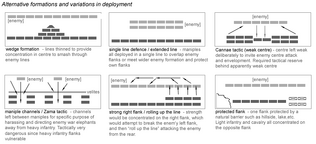
The Roman Army was mostly infantry based, with the cavalry made up almost entirely (if not completely) of auxiliaries from across the empire or without. Obviously it was very variable and changed due to the time, the enemy, the strategy, the general and also due to the terrain. They tended to stay together and there aren't many examples of a Roman army split in half, at least not that they wanted to do so. The variations below were the more "classical" ones. A variation of the first and the second formations were used in the famous and remarkable victory against Boudica in Britain. The hammer and anvil tactics used by Caesar, Scipio, Paullus and Germanicus at Idistaviso proved to be one of the most deadly tactics in Roman history. Roman generals would use a feint or set a trap in the opening of a battle and they would throw their two pila, causing enemies to flee the action and incumbering their movement. They would draw their gladius and try to stab into the enemy or use their shield to bash the enemy, normally right in the face, dealing massive damage. The Roman commanders after Scipio Africanus would try to smash the flanks of the enemy before wheeling onto the enemy at a massive offensive with the center included. Unlike Greek commanders, the Roman commanders would not engage in combat but they would sit on their horse near the back line, carrying runners out to deliver orders or tactical maneuvers.
Roman Army[]
In the mid-republic, the Roman military included Velites, which were light skirmishers, Hastatii, which were the inexperienced but mighty soldiers, Princeps, which hard-hit Carthage and the Greeks and finally the Triarii, the revered veterans who literally bashed Hannibal at Zama, winning the battle on the flanks with a numerically inferior numbers. It was organised into maniples- groups of 120 men. The Roman army can enlist more than 700,000 men at its height after the Punic Wars. These legions could easily crush a Greek phalanx with its superior mobility, hand-to-hand fighting skills, techniques, coordination, speed and quality. The power of the empire depended on the might of its professional armies. Therefore, the Roman Army was divided in legions. Every legion was composed of ten cohorts (the first being the most prestigious one, then the second and so on) that were each composed of six centuries of eighty soldiers (and twenty non-combatants). Roman legions were often outnumbered in battle but they normally gained victory. Later on, the Augustan reforms had doubled the size of the first cohort. At the height of its power, Rome had more than 1 million soilders that they can call on. Normally the commanding officer of the first century commanded the entire cohort. This totalled to be approximately 4800 that were under the command of a general (sometimes more than one legion was commanded by one person, depending on the amount of imperium the general had). Almost every emperor was a general. They only commanded big campaigns or tough battles leaving the "normal" ones to their generals. The emperor Aurelian was an exception to this. He commanded in every single campaign he went for, from Zenobia to Tetricus and from the Jugunthi to the Vandals. At its prime, Rome was an unstoppable force of numerous legionaries- battle hardened and experienced- with generals such as Scipio Africanus, Gaius Laelius, Gaius Marius, Lucius Cornelius Sulla and Lucius Licinius Lucullus. A special trait to the army was that- they fought to the end, no matter what the circumstance and always never surrendered, replacing lost armies with fresh talent. The Second Punic war was a show of this mentality. They had disastorus defeats at Trebia, Trasimene and Cannae but they just kept on replacing their armies with new and bigger ones until Scipio Africanus destroyed armies in Spain and Hannibal was forced to return to Africa after the Hasdrubal Gisco's defeat at the Great Plains and Numidian king Syphax's defeat at Cirta.
Soldiers belonging to a legion were called legionaries. They were highly trained and well equipped with short swords (the gladius, and eventually, the longer spatha was adopted), sub-rectangular shields (scutum), and throwing spears (pila). They built roads and forts to defend their conquests.
Fleet[]

Roman Fleet
The Romans had quite an efficient navy throughout most of their history, which made it much easier to travel long distances and to transport goods or even orders throughout the empire. They didn't invest on their military navy as they did on ground troops but it indeed had a considerable number of ships and men. Like at Ecnomus, 1,000 battleships that the Romans built was formidable. The Imperial Roman Navy had two main bases; Misenum (located in the Bay of Naples), which housed the western fleet (Classis Misenensis) and Ravenna, the sight of the eastern fleet (Classis Ravennas), located in northern Italy. Due to Rome's dominance over the Mediterranean, the sea was sometimes referred to as the "Roman Lake" or Mare Nostrum ("our sea" in Latin). Also, they used their fleet to maintain the frontier with the Germanic tribes, always keeping boats traveling up and down the Renus and Danubius.
Emperors[]
Augustus - The first emperor and grandnephew of Julius Caesar, Augustus (originally named Octvian) re-organized the political, judiciary and tax system that all the others emperors would follow. A patron of the arts, he established the Panem Circenses (the "bread and circus" in Latin) and the Pax Romana, which saw almost 200 years of relative peace and stability. He ruled from 27 B.C.E. until his death in 14 C.E..
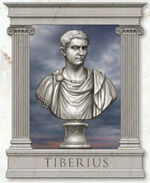
Emperor Tiberius
Tiberius - One of Rome's greatest generals, he expanded the northern frontier of the Roman Empire and conquered Pannonia, Dalmatia, Raetia and temporarily, Germania. His wife was a woman named Vispinia whom he fell in true love with, but Augustus forced him to divorce her to marry his own daughter, Julia. Tiberius did not have Augustus' natural rapport with the Senate, he heavily relied on the brutal head of the Praetorian guard, Sejanus. Infamous for supposedly orchestrating the exile and death of Germanicus, his nephew and designated heir. Retired to Capri and had Sejanus executed for trying to seize power. Was killed by Sejanus' replacement, Naevius Sutorius Macro, in March 37 AD.[2]
Caligula - Infamous for his insane reign as emperor. He killed his rivals and forced parents to watch their sons' executions. He ordered a bridge to be built between his palace and the Temple of Jupiter. He even dressed his right-hand horse, Incitatus, in senatorial purple and tried to make him a consul. Was assassinated by his praetorian guards in January 41 AD.
Claudius - The bumbling[3] uncle of Caligula who was declared the new emperor by the praetorian guard. Although he lacked a military reputation, the essential attribute of an emperor, in 43 AD Claudius undertook the conquest of Britain. Nero succeeded Claudius as emperor when the latter fell ill and died in the early hours of 13 October 54 AD, allegedly poisoned by his niece and fourth wife, Agrippina the younger.
Nero - The last of the Julio-Claudian dynasty, he is best known for having "fiddled while Rome burned" in 64 AD. One of Rome's most infamous rulers, he was well-known for his persecution of Christians throughout the Empire. He met his end at his own hands, committing suicide in June 68 AD.
Galba - Governor of Hispania Tarraconensis, Servius Sulpicius Galba took advantage of Nero's suicide to obtain the throne through military support. Galba was the oldest emperor to date when he became emperor, he was killed by Otho who rebelled against him and took his place, his reign began the Year of the Four Emperors.
Vespasian - The founder of the Flavian dynasty, he reunited the falling empire and ascended as a strong emperor following the period of civil unrest known as the Year of the Four Emperors. He also restarted the campaigns in Judaea.
Titus - Again one of the greatest generals ever recorded. The eldest son of Vespasian, he retook Jerusalem in 70 AD (leading to the destruction of the Second Temple) and was known for his generosity towards the victims of Pompeii and with the Roman citizens after its fire. Among his accomplishments were the completion of the Flavian Amphitheatre in 80 AD; the structure is now known today as the Colosseum.
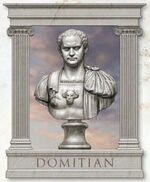
Emperor Domitian
Domitian - Became emperor after his brother Titus died, rumors were that the former poisoned the latter for the throne. Reign was relatively peaceful at first, but later years made him secretive and cruel due to greed and fear of assassination. Enacted high taxes to pay for his own overspending, stripped the Senate of much of its powers, executed senators and imperial officers for minor offenses like being too popular. As his paranoia grew, Domitian cut the hands off prisoners to get information and daily walked with a moonstone that would reflect everything behind him. But in 96 AD, he was hacked to pieces by conspirators, including his wife.[2]
Trajan - The second of the Five Good Emperors, he built Trajan's Market (Mercatus Traiani), the largest market the world had ever seen, which lay within his personal forum (Forum Traiani). He was one of Rome's greatest generals, under whom the Empire reached its greatest height; his conquests included Dacia (a region north of Greece and east of the Danubius), Armenia, Parthia and Mesopotamia. He sacked Cstephion during his Parthian conquest and he also sacked the Dacian capital Sarmazegatusa with a numerically inferior army but he had superiority in quality, leadership and logistics since he cut off the Dacian’s supply lines and water pipes during a short and easy siege and starved them out. By 105 AD he was officially declared optimus princeps ("the best ruler") by the Senate.
Hadrian - Built Hadrian's Wall, that crossed northern Britain from East to West and was 75 miles (120 km) long. It was built to defend Roman lands from the fierce, unconquered tribes who lived in the mountains of Scotland. The Wall is the world`s second largest wall after the Great Wall of China. Noble Hadrian had no major military conflict but he built numerous buildings (including the Pantheon) and fortified Roman economy and territory.
Marcus Aurelius - Co-emperor with Lucius Verus and later his son, Commodus. He was a kind and wise ruler but also the sternest and most powerful father in the world next to Zeus. They both loved to lecture and remind their offspring of how lucky and privileged they were and how far short they fell of their fathers' expectations.[4] The fifth and last of the Five Good Emperors, Aurelius died of natural causes in 180 AD.
Commodus - Originally co-emperor with his father, Marcus Aurelius, became single emperor after his father's death. Left all the decision making to his advisors so he could spend his time in the Colosseum. He was assassinated by his personal trainer, Narcissus, in his bath tub in 192 AD.
Pertinax - The city prefect was proclaimed emperor the day after Commodus was assassinated. But his reign was short lived as he was killed by his soldiers two months after taking the throne. He was the first to fall victim to the Year of the Five Emperors.
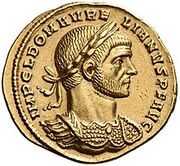
Emperor Aurelian, one of the best emperors in history
Aurelian - He was a brilliant emperor, he defeated the Gallic and Palmeryne empire simultaneously and reconstituted a stable, resurgent and powerful empire to the later emperors. His exploits included the clemency to reinstate the Palmyrene empire back into the Roman empire and using diplomacy and war in order to reincorporate the Gallic empire back into the Roman empire. His rule is considered the end of the Crisis of the Third Century. He infamously won the battle of chalons and defeated numerous Germanic tribes like the Jugunthi in numerous battles such as the Battle of Paris where he annihilated the whole Germanic army facing him at the classic site of the Metaurus. He later planned to launch an expedition into the Sassanid empire. However, unluckily for the empire, Aurelian was assassinated in 275 AD, this was the end of a great emperor who reunified the Roman Empire and brought great glory to the Augustan Roman legion. This was the end of the unstoppable Roman legions and Diocletian would reform the legions into a Greek hoplite style force which was totally ineffective against threats like the sassanid empire and the Germanic tribes.
Claudius Gothicus - Also known as Claudius II, he was Roman emperor from 268 to 270 during the Imperial Crisis. He allegedly made a law that banned marriages. However, one Roman saint named Valentine, of whom Valentine's Day was named after, performed many wedding ceremonies until he was arrested and imprisoned. Although he attempted to convert the Emperor Claudius, he was condemned to death and executed. Claudius II died of plague while fighting another battle in January AD 270, his brother, Quintillus, became the new emperor.[5]
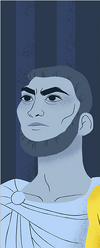
Diocletian
Diocletian - Created the Law of the Maximum, there were a price crises, and established the Tetrachy, wherein two Caesars and two Augusti ruled over the western and eastern halves of the empire. The period of history which followed is referred to as the "Dominate", as Diocletian would refer to himself as Dominus et Deus (“Lord and god”). He was a demigod of Jupiter, the last great pagan emperor, and the first to retire peacefully.[6]
Constantine the Great - The first Christian Emperor, founded Constantinople (formerly Byzantium) as the new capital, and stabilized the Roman economy. He fought with success the rebellions and barbarians that appeared (and there were a lot of them) and established religious tolerance.
Theodosius I (Theodosius the Great) - The last emperor to rule over the united Roman Empire until he divided it into the Eastern and Western Empire in 395 A.D.. He was known for closing all the ancient and pagan temples across the empire and officially prohibited pagan worship when he made Christianity the official religion. Theodosius also cut down the last oak of the original Grove of Dodona. Apollo described him as a bully who evicted the Olympian gods, he used to have an archery target with his face on it.[7]
Honorius - The younger son of Theodosius, Flavius Honorius became the Western Roman emperor after his father's death. His principal general and guardian was named Stilecho until his execution. He had an unusual fondness of poultry, with his favorite chicken named "Roma". During his reign, gladiatorial games were banned due to the martyrdom of a Christian monk named Telemachus.[8]
Justinian I (Justinian the Great) - Built the Hagia Sofia and started to dramatically expand the Eastern Empire to where once lay Rome and to the borders of the Atlantic, retook Hispania, and even dominated most of the Black Sea's coast. He also developed the concept of Caesaropapism (Cäseropapismus - which unified both political and religious power), wrote the Corpus Juris Civilis (a codification of Roman law compromised of the Codex, Digesta/Pandectae, and Institutiones) and controlled the riot of Nika.
Fall[]
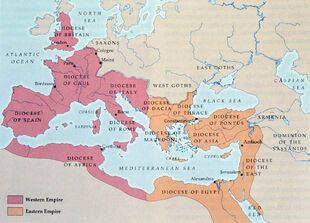
As the barbarians closed in on the Empire it was split into the Eastern and Western Empire (the Eastern Empire was by far, more rich but the Western was more militarily better but it was led by dumb Emperors). Later emperors would reunite the empire but their efforts proved to be in vain. The Western Roman Empire collapsed in 476 as the last emperor, Romulus Augustus, was forced to abdicate to the Germanic warlord Odoacer on September 4. Although the name Romulus Augustulus ("Little Augustus") recalled more than centuries of Roman glory, it could not save the empire from collapsing. After the Western Empire fell, the East lived on much longer as the Byzantine Empire, until it fell in 1453, with the capture of Constantinople by the Ottoman Turks, led by Mehmed II.
Of course the empire never truly died and attempts to recreate it last until modern times. In 800, Charlemagne was crowned Emperor and founded the Holy Roman Empire that would after be Holy Roman-German Empire and that would last more than a few hundred years. Soon after the fall of Constantinople, Moscow claimed to be the third Rome and the descendant of the Roman Empire. Another attempt was made by Mussolini during World War II, when he declared that the new Italian empire in Europe would be 'the Second Roman Empire'.
Reasons for the Fall of the Western Roman Empire[]
The Roman Empire, before the division between the western and eastern empire, was threatened by enemies, but every time the Romans cleaned up and things came back to "normal". Nevertheless, the "last fall" of Rome occured in 476 AD, when the last Roman emperor Romulus Augusulus was deposed by a Germanic chieftain named Odoacer. This marked the fall of the Roman Empire in the west. There were many reasons for its fall but the majority of them can fit into these three categories:
Military reasons: The Roman Empire was too big to be properly defended. Of course, it was attacked many times but when barbaric tribes felt Rome was weak they simply went to get it all. Iranic, Celtic, and especially Germanic tribes were invading the Eastern Roman Empire and the Romans didn't have enough soldiers and strength to defend the borders. The Romans recruited many soldiers from outside Italy into the army but their loyalty was dubious. Loyalties aside, the leaders of these foreign troops often had their own agendas and especially during the late Western Roman Empire, they would act only if it benefited them and their people.
Economic reasons: There were many problems in Rome. Their production system based on slavery was collapsing since they hadn't dominated other territories nor slaves. Many Romans had to pay huge taxes that hurt the economy and trade. Rome wasn't the largest city in the west and its importance to Europe's economy was falling. Other cities, mainly Constantinople, were becoming more attractive to make business and were becoming capitals of growing empires. Rome also faced many recessions, brought on by civil war and chronic overspending (especially on the army).
Political reasons: One of the main reasons for the fall of the Western Roman Empire is that Rome could not find a new leader to rule the empire. Emperors were overthrown before they could take full control of the Empire. Another reason for the Fall of the Western Roman Empire is that diseases killed many Romans and affected the population and Rome's morale. The political instability (especially during the Third Century) and ineptitude of some (if not many) of the later emperors would lead to the downfall of the Roman Empire (at least, in the west).
All those factors culminated in the fall of the Empire and it's considered today that none of them alone could have caused as much damage as they did together.
Percy Jackson and the Olympians[]
The Last Olympian[]
The Roman Empire is not directly mentioned, but it is said in The Lost Hero that a contingent of Roman demigods from Camp Jupiter were led by Jason Grace to destroy the Titans' base at Mount Othrys while the Greeks were defending Manhattan and Mount Olympus from Kronos and his forces.
The Heroes of Olympus[]
The Lost Hero[]
In the end, demigods from the Greek Camp Half-Blood discover that there is really a Roman Camp that is presumed located near San Francisco in the United States of America. Just like the Olympian gods and Mount Olympus following the center of the power of Western Civilization, the Roman version of Camp Half-Blood called Camp Jupiter, founded when Western Civilization once stayed in Ancient Rome, has its own version of the Greek deities.
Camp Jupiter[]
- Main article: Camp Jupiter
The Roman camp is a smaller version of the Roman Empire itself called New Rome, although it has the likeness of the Greek camps called Camp Half-Blood and Camp Fish-Blood. However, like its patronages (the Roman gods and goddesses) and the Roman Empire, the camp itself takes great care in the training of Roman demigods and legacies in the militaristic motto of the Roman Empire.
Like the Roman Empire, the camp's training is focused on discipline and loyalty. The camp's activities director, a she-wolf named Lupa (the one who took care of the founders of Rome: Romulus and Remus), takes in the ideals of the Roman Empire. They also have an underground "city" called New Rome which could possibly be a Roman version of Olympus. However, the numbers of it were diminished compared to the original might of Rome
Location in the United States of America[]
Camp Jupiter is near San Francisco Bay, California, in the United States of America. In the first chapter of The Son of Neptune, Percy finds it under a hill, in a tunnel, after having fought Medusa's sisters, Stheno and Euryale. (In The Lost Hero, Jason asked Piper about the Caldecott Tunnel while the were riding a helicopter to the Wolf House).
Trivia[]
- Purple was the most expensive color in the Roman Empire, being considered the color of the powerful or rich due to the cost of the dyeing process. It`s also known for its horrible smell because of the snails that needed to be left in the sun to make the color.
- Julius Caesar was the second person added to the Pantheon, where statues of all the gods were held, after Romulus, who founded Rome.
- Pax Romana is a term used to describe the period of relative stability and peace in the first two centuries of the Roman Empire, from the time of Augustus to the death of Marcus Aurelius in 180 AD. Since it was established in the reign of Augustus, it is also referred to as Pax Augusta.
References[]
- ↑ Overthrow of the Roman monarchy
- ↑ 2.0 2.1 Apollo's Least Favorite Roman Emperors; Companion to The Dark Prophecy.
- ↑ The Burning Maze, Ch. 10
- ↑ The Dark Prophecy, Ch. 13
- ↑ Claudius Gothicus - Wikipedia
- ↑ The Blood of Olympus, Glossary
- ↑ The Hidden Oracle, Ch. 21
- ↑ https://en.wikipedia.org/wiki/Honorius_(emperor)
